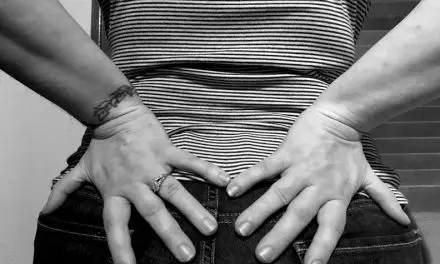Daddy, I got owie!
My toddler says this often and usually goes out of his way to announce it. I usually give the spot a kiss or two, and then he goes back to what he’s doing.
Problem solved, presumably because daddy’s kisses are magical. At other times when he has a fever with widespread aches and pains, he instinctively grabs my hand and holds it on the side of his face.
Most of us are familiar with this as adults, too. We ask someone to be with us and hold our hands during painful procedures or illnesses, for instance, and we do this because we know it helps. But how? Should we conclude that our lips and hands exude healing powers that instantly heal tissue, or does the social and/or tactile intervention somehow only change the perception?
In this article, these questions will be addressed by examining a powerful and underappreciated mechanism that’s hiding in plain sight: descending modulation.
Descending modulation and pain
Even though we know holding hands helps, there’s still a way in which we don’t take such interventions seriously, perhaps because we assume that it’s not fixing the “real” problem.
After all, if pain is caused by tissue injury, then holding hands is just smoke and mirrors. But what if tissue injury is not the real problem?
The common view of pain holds that tissue-damage receptors send signals to the brain where pain is experienced in proportion to the amount of tissue damage. This view might seem like a close approximation some of the time, but it’s actually incorrect.
In particular, when looking at chronic pain with no obvious damage that can be viewed on an X-ray or MRI, this view of pain leads practitioners to dismiss the client’s pain as being made up in one’s head. It may lead clients on an expensive wild goose chase of treatments, therapists, exercises, supplements, blood tests, and diets in an effort to find the “real” tissue-based problem.
Nociception’s role in descending modulation
Our tissues contain numerous receptors that are specialized to detect mechanical, thermal, and chemical stimuli. Any subset of these that detect danger are called nociceptors, and the process of transmitting these signals is called nociception.
(Note: Because pain is a subjective experience and nociception is not, it’s a misnomer to say pain receptors or to use nociception and pain interchangeably.)
Nociceptive signals, like tactile signals, use three neurons to transmit a signal from the receptor to the cortex.
The first neuron goes to the dorsal horn of the spinal cord where it interacts with interneurons that may generate protective muscle reflexes. From there, the second neuron on the pathway goes to the thalamus, a relay center for all sensory input except for smell.
Along the way, some fibers make collateral connections with brainstem regions, such as the periaqueductal gray and the rostral ventral medulla, as well as the raphe nucleus and the reticular formation, which are responsible for producing norepinephrine and alertness.
The third neuron then continues up to the somatosensory cortices (S1 and S2), which create the conscious and localized experience of pain, or up to limbic regions (anterior cingulate cortex and posterior insula), which create the unpleasant emotional quality that motivates aversive behavior.
When presented with a noxious stimulus, people with damage to the anterior cingulate will report feeling pain that isn’t unpleasant, whereas those with damage to S2 will report unpleasantness but won’t call it pain. The posterior insula seems to integrate both regions and is thought of as the primary pain center.
Descending modulation: anatomy and physiology
Perhaps the most important concept to understand in the neuroscience of pain is descending modulation, wherein nociceptive regions in the brainstem (e.g. periaqueductal gray, rostral ventral medulla, raphe nucleus) are being modulated by descending inputs from cortical regions (e.g. prefrontal cortex, the anterior cingulate cortex, and the orbitofrontal cortex) and limbic regions (e.g. amygdala, hypothalamus, and insula) that are assessing the organism’s overall safety.
The modulation can turn the volume up or down on the ascending nociceptive signals. Turning it up is called descending facilitation and turning it down is called descending inhibition. The disruption of descending inhibition is thought to lead to chronic pain conditions.
Descending modulation in the brainstem is mediated by a complex array of neurotransmitters, including norepinephrine, serotonin, GABA, and endogenous opioids that are thousands of times stronger than morphine.
Oxytocin, which is released from the hypothalamus in seemingly all pro-social contexts (including, presumably, holding hands), also plays an important inhibitory role. These modulatory signals also descend to the spinal cord to affect ascending nociceptive signals and nociceptive muscle reflexes there.
Pain represents danger, not tissue injury
Pain is a subjective experience that has evolved as a compelling strategy for getting your attention and motivating it to address conditions that seem unsafe. But chronic pain doesn’t actually need to be tied to nociceptive input to show up—cognitive and affective inputs can suffice as well.
So, pain doesn’t require nociception, and conversely, most nociceptive activity does not result in the experience of pain.
In fact, nociception is neither a necessary nor a sufficient condition for pain.
Whether pain is experienced or not depends on how these ascending nociceptive signals are modulated by the descending signals from higher cortico-limbic regions that are evaluating safety and context.
A non-pain example of how cognitive context affects perception is how your tactile experience changes dramatically if you think that there might be spiders, ants, or insects under the bed sheets, or if you learn that your lover has lice.
In the book Painful Yarns, neuroscientist Lorimer Moseley offers similar context-dependent examples and demonstrates how pain is coupled with perceived danger, not tissue injury.
He tells a humorous story of how his sense of being in a non-threatening environment led to a complete lack of pain (descending inhibition) in response to what was actually a true threat (a poisonous snakebite).
Then he tells how this snakebite experience later created an enhanced pain experience (descending facilitation) to something completely non-threatening (a scratch from a stick). For those with trauma, there’s a raised baseline of unsafe outputs from the amygdala and a greater likelihood that some specific safe stimuli or situations will register as unsafe.
Watch the video here.
The result: descending facilitation of nociceptive signals, wherein the facilitation occurs not only from the brainstem up to the cortex, resulting in more pain, but also from the brainstem down to the spinal cord, resulting in heightened protective muscle responses.
Continued frustration with such experiences can lead to catastrophizing, which is the act of fearing that things will never improve, which may create a self-fulfilling prophecy through further descending facilitation mechanisms.
Factors that affect pain experience
Some of the primary factors that influence a person’s pain experience (via descending modulation) in a clinical setting include:
- Environmental cues—does the space feel safe and promote positive expectations?
- Client conditioning—does the experience align with prior associations of safe places and people?
- Client expectations—What has the client read, heard, or experienced about the treatment’s efficacy and the therapist’s skill?
- Client agency—does the client participate in his healing process or believe he has the ability to influence the outcome?
- Therapeutic alliance—is there a sense that the client and therapist are working together towards the client’s goals?
- Social support—does the client feel cared for and attuned with the therapist and others?
- Verbal cues—is the therapist’s communication affirming and reassuring?
- Quality of touch or movement intervention—is it safe and soothing?
Placebo effect in descending modulation
Many of the factors listed above are related to what has been traditionally referred to as the placebo effect.
If you take the common view of pain and think of it as being real in the tissues, you must then conclude that either the placebo effect is a fake effect or your mind is somehow changing the pain at the source in the tissue in a miraculous “mind over matter” sort of way.
But both of these perspectives miss the point: as social creatures, we’re designed to take care of one another and respond to social cues.
Once you understand that pain is an experience the brain creates to motivate the organism, then the idea that top-down processing from cortical and limbic centers can affect whether your pain experiences isn’t a stretch at all. In fact, it becomes a matter of course.
In medicine, it’s very difficult to find a treatment that’s more effective than placebo. This is especially true if pain is what is being treated. This is why most people find that most types of massage therapy work, regardless of what intervention is being applied.
The best way to have an impact on descending modulation networks is to create a sense of safety, and this isn’t driven by any techniques learned in advanced massage therapy workshops. It’s driven by the quality of the therapist-client relationship, which is ultimately about the massage therapist’s ability to:
- be present
- listen and communicate effectively (verbally and nonverbally)
- offer safe, responsive touch that is aligned with what the client’s body wants
On the client’s side, it’s about their level of:
- pain education
- involvement in their healing process.
Maximizing these qualities in one’s practice makes an effective therapist because these qualities have an enormous impact on descending inhibition.
How massage therapy alleviates pain
The profound implication of descending modulation is that pain can be strongly affected in a therapeutic context strictly by the therapist-client relationship, client expectations, and environmental cues. All of this can happen without any touch, but the addition of any kind of touch is going to further contribute to the modulatory effects.
As long as the touch isn’t strongly activating nociceptors and nothing else is setting off limbic safety alarms, those modulatory effects should be inhibitory.
There are at least three important ways that touch can enhance these descending inhibition effects.
- Faster, non-nociceptive tactile signals will reach the spinal cord before some of the slower nociceptive signals, and as a result the nociceptive signals will be thwarted. This is called gating or ascending inhibition.
This occurs in almost any therapeutic session that involves tactile input (e.g. massage, chiropractic, acupuncture) and can positively influence the client’s expectations for future sessions and further enhance descending inhibition after the session and during subsequent sessions.
- Touch that is applied at a moderate speed will generate signals that are transmitted on C-tactile fibers to areas in the limbic system that create an experience of pleasant, sensual touch, which will further enhance descending inhibition.
- The mere fact that one is being touched in a caring way creates a primate social grooming effect that will further enhance descending inhibition via oxytocin release.
With an understanding of how pain is modulated, it becomes clear that what makes a therapist effective has much less to do with manual techniques and far more to do with one’s ability to induce descending inhibition.
Clients walk out of a massage session feeling better, not because circulation was altered in the tissue or because of any direct mechanical manipulation of soft tissues, but because of the symphony of nociceptive modulatory activity that emerges from the meaning the client derives from environmental and social cues.
Once we understand that the tissue is (often) not the issue and how pain is generated and modulated in the brain, we can realize that placebo effects are nowhere near fake but rather an essential therapeutic tool to wield against the real basis for pain.
Understanding the mechanisms of descending modulation’s nonspecific effects means that our treatment strategy doesn’t require mechanical focus on the region with the pain.
It also means that educating our clients about how pain works becomes part of the treatment (since it can further enhance descending inhibition), and that what and how we communicate to the client about their condition plays a much more central role than what would be expected with the common, passive, unidirectional, tissue-centric model of pain.
Classes on effective listening and communication skills may truly be more valuable than classes in one massage modality or another.
Massage therapy, like kissing owies or holding hands, effectively engages descending inhibition circuitry because it offers a unique combination of safe, reassuring, tactile and psychosocial inputs that aren’t offered in doctors’ or psychotherapists’ offices.
As massage therapists, the more we develop our skills along the entire biopsychosocial spectrum, the more effective we will be in reducing our clients’ pain.

Mark Olson, PhD, LMT
Mark Olson, Ph.D., LMT is the director of thePacific Center for Awareness and Bodyworkin Kaua`i andAffinity Wellness Educationin Florida.
He has an M.A. in Education and a Ph.D. in Neuroscience, specializing in Cognitive and Behavioral Neuropsychology and Neuroanatomy from the University of Illinois where he studied memory, attention, and eye movements.
Mark’s courses offer advanced knowledge and skills in manual therapy, affective neuroscience, somatic psychology, trauma studies, and relational skills to support helping professionals in providing a more informed and compassionate level of care.





